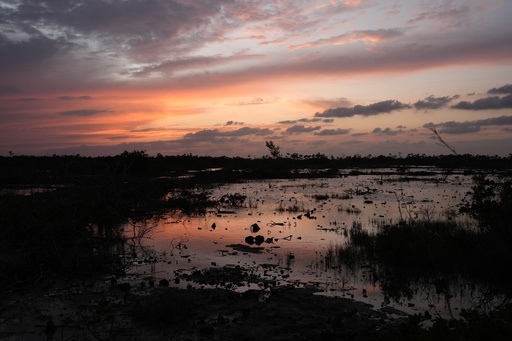
BIG PINE KEY, Fla. — The Key deer—the smallest subspecies of white-tailed deer—inhabit the unique pine and marshy wetlands surrounding the Atlantic Ocean and Gulf of Mexico in the Florida Keys. Previously, these animals faced the greatest risk from vehicles traveling along U.S. Highway 1 and local roads. However, as sea levels continue to rise, the surrounding waters have emerged as a significant long-term threat to this small herd, which numbers around 800 deer.
These small yet endearing deer have been classified as endangered for nearly six decades, a designation that came about when their population plummeted to nearly 50 due to hunting and poaching. Fortunately, through conservation efforts, their numbers rebounded to about 1,000 around the mid-2010s. Nonetheless, a deadly parasite and the devastation caused by Hurricane Irma have taken a notable toll on the population. Experts and wildlife advocates now warn that this recovery story is at risk due to climate change-related challenges. Rising sea levels are altering the landscape of Big Pine Key and twenty other smaller islands that serve as the deer’s habitat.
Most Key deer are found on Big Pine Key, an island approximately 30 miles (48 kilometers) from Key West. They inhabit areas where around 4,500 people reside, often seen foraging through gardens and drinking from buckets filled with water that local residents provide, as natural freshwater sources diminish. Key deer are considerably smaller compared to other deer in North America, with adult males rarely exceeding 3 feet (1 meter) in height at the shoulder and weighing around 75 pounds (34 kilograms).
Chris Bergh, the South Florida program manager for the Nature Conservancy, stated that the deer have always faced vulnerability, but the situation has worsened due to rising sea levels and shrinking habitat. He highlighted the risk posed by the environment and the increasing competition for land between the deer and the area’s human population.
Traffic incidents still pose a significant threat to the deer population on Big Pine Key. The busy U.S. 1 is lined with local bars, restaurants, gas stations, and small motels, and the main economy is centered around aquatic activities like fishing, diving, and vacation rentals. To minimize vehicle-related deer deaths, warning signs are placed to alert drivers when entering deer habitats. A specific two-mile (3.2-kilometer) section of U.S. 1 is elevated and fenced to facilitate safe crossing. Despite these measures, it is estimated that between 90 and 120 deer fall victim to traffic collisions each year, according to Jan Svejkovsky, chief scientist for Save Our Key Deer.
Wildlife officials have emphasized the importance of not feeding Key deer, which can encourage the animals to approach vehicles in search of food. While the population has remained relatively stable, the looming threat of climate change adds another layer of complexity.
According to projections from the National Oceanic and Atmospheric Administration, sea levels could rise between 1.5 feet to 7 feet (0.5 to 2 meters) by the year 2100 in parts of the Florida Keys. Low-lying islands such as Big Pine Key, which stands only about 8 feet (2.4 meters) above sea level, face the greatest danger. As sea levels rise, the availability of freshwater and food necessary for the Key deer dwindles. Bergh noted that the impacts of rising seas will create increased competition for essential resources, forcing deer further into conflict with humans.
Aside from rising sea levels, climate change also brings the threat of more powerful hurricanes, leading to storm surges that can devastate deer habitats and freshwater supplies. Additionally, saltwater encroachment is killing Florida slash pines, which are being replaced by mangroves, further constraining the deer’s environment.
As habitat shrinks, Key deer increasingly invade residential neighborhoods in search of food, often warming the hearts of local community members, who sometimes name the frequent visitors. Connie Ritchie, a local resident, expressed her affection for the deer, remarking on their gentle demeanor. She noted their favorite native plants and shared that the federal deer refuge organizes events to distribute suitable plants for community members to cultivate.
Development on Big Pine Key began in the 1970s and 1980s when land that supported the deer was transformed into planned subdivisions with saltwater canal access. Although the island remains mostly rural, development continues to eat away at valuable deer habitats. Katy Hosokawa, a park ranger at the National Key Deer Refuge, noted that increased human encroachment squeezes the deer into confined spaces, limiting their safe areas to roam.
The outlook for Key deer appears bleak as rising sea levels and habitat loss loom over their survival. According to Nova Silvy, a professor emeritus at Texas A&M University who has studied the species for decades, just six inches (15 centimeters) of sea rise by 2030 could result in the loss of 16% of the freshwater resources they depend on. Projections for 2050 indicate that up to 84% of the remaining suitable habitat on Big Pine Key could be submerged, leading to drastic declines in the Key deer population.
In light of these concerns, Bergh suggested that efforts should be focused on prolonging the deer’s survival in their current habitat and, as a final measure, consider relocating them to controlled environments like zoos for preservation. However, he acknowledged the challenges associated with such measures, particularly regarding genetic interbreeding with other deer populations.
